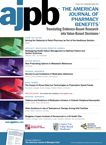Publication
Article
AJPB® Translating Evidence-Based Research Into Value-Based Decisions®
Solving the Obstacles to Retail Pharmacy as Part of the Healthcare Solution
Author(s):
To achieve the triple aim, the healthcare benefit and the pharmacy benefit must evolve.
This is the fourth and final commentary on the use of retail pharmacies and pharmacists in addressing Don Berwick’s triple aim1 of 1) access, 2) quality, and 3) cost. If you read my commentaries in the previous issues you would notice that none of these 3 areas are discrete and many areas overlap. You would also probably feel that many of these ideas are “nice” but not easily achieved. You may also wonder why these ideas are being expressed in a journal focused on pharmacy benefits. I will now attempt to address some of your questions.
First, let’s concentrate on some of the barriers to pharmacies supporting the triple aim as I articulated them. I want to begin by stating that pharmacists should replace other healthcare providers (ie, physicians). We are in the early stages of primary care shortages. We need to utilize this precious commodity where it is most needed, such as with complex patients and complex problems. This is not to say that we need greater fragmentation in our healthcare “non-system.” I have suggested before and will again that patient-centered care consists of the members of the patient’s healthcare neighborhood all doing their part and sharing patient-centric information. In order to have this information available to all parties it will be important to have pharmacies included as health information exchanges are formed.
Primary care physicians will have to become comfortable with others being part of the team. They do not have to be the sole providers of healthcare services to their patients, but should act as the quarterbacks. Some physicians may say that a pharmacist or a retail clinic is not as trained to give care, is their competition, or is taking away their business. As I stated in an earlier column, pharmacists are better trained than physicians in their knowledge of medications and are equally trained in the administration of immunizations. In regard to the concerns around competition, I would say that there will be plenty of business to go around if we all do our part and have a payment system that is aligned. I was very interested in seeing the recent announcement about the healthcare partnerships between Walgreens and 3 accountable care organizations.
Another area that would have to be addressed in order to achieve the desired goals incorporated in the triple aim would be reorganization and restructuring of the actual pharmacy itself and how it operates. We have begun to see these types of changes occur already in both Walgreens and CVS stores. It is early in this evolution but I am very optimistic that the changes can have a positive impact on all stakeholders.
The final question that needs to be addressed is how these activities will be paid for. I would agree that in some ways this has the potential to be one of the greatest barriers. This is also the tie into this journal. The healthcare benefit in general, and the pharmacy benefit in specific, need to evolve. I believe that we need to begin to bring together thoughtful people to see how the next generation of benefit structure can help support the changes we need in order to improve the care and outcomes of healthcare in this country.







